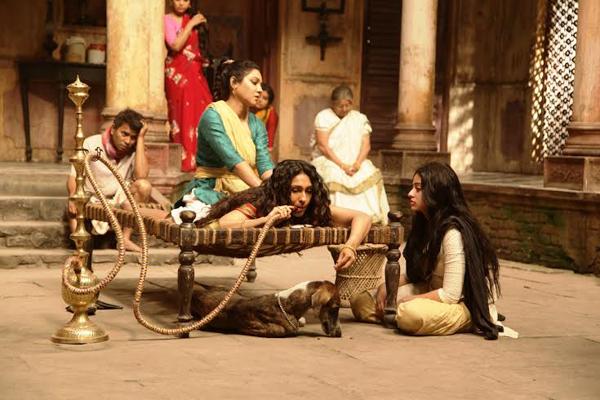 Image
Image
Lost women of Partition
While the world even now faces an unprecedented refugee crisis, a Bengali film on the Partition of India in August 1947 takes us to one of the most brutal phases in the history of refugees victimised by forced migration. Shoma A. Chatterji tracks back to Indian films that dealt with the Partition and examines how Rajkahini by National Award winning filmmaker Srijit Mukherjee stands within this cinematic world.
Facts state that as a result of the Partition, nearly 12 million Hindus, Muslims and Sikhs migrated across the newly established borders and more than one million died or were maimed in the inter-ethnic violence. The aftershocks resound to this day..jpg)
Every filmmaker has the liberty to interpret his subject in any which way he thinks fit, that includes ‘creating’ a story from within the pages of history and investing it with the pretence of reality. Most films on Partition in India are based on works of literature by noted writers.
Ghatak wrote some of his own stories but then, he was a writer in his own right. His Meghe Dhaka Tara was adapted from a novel by Shaktipada Rajguru. Train to Pakistan (1998) directed by Pamela Rooks was based on a story by Khushwant Singh. Garm Hawa (1973) directed by M.S. Sathyu was adapted from a work by Ismat Chughtai. Deepa Mehta’s 1947 –Earth(1999) was based on noted author Bapsy Sidhwa’s The Ice-Candy Man though some sources show Deepa Mehta as the writer of the story. So, the seeds of reality were sown in the literary source itself.
Newest addition to this, Rajkahini, a just released Bengali film, is based on a story and screenplay by the director Srijit Mukherjee and does not belong to any literary source. This marks a point of difference because Mukherjee was born decades following Independence and has culled his sources from several works of history and classic fiction.
Garm Hawa was the first film to deal with the human consequences resulting from the Partition. This action, ordered by British Lord Mountbatten, split India into religious coalitions, with India remaining Hindu and the new country of Pakistan serving as a refuge for Muslims. Till date, Garm Hawa is probably one of the best celluloid documents that outlined and then fleshed out the pathos of the Partition and the tragedy of the minority community which suddenly began to find itself driven away from the mainstream especially in terms of economic survival. It is a story about a Muslim family that chooses to stay back in India after Partition in 1947 but gets mired in personal struggles and tragedies in the process of wanting to stay back.
But Rajkahini is different. It is an imaginary, hypothetical fiction created by the director who states that his film is based on the arbitrary physical division of India into India and Pakistan in August 1947.
Rajkahini spells out how the arbitrariness of the Radcliffe Line drawn by Sir Cyril Radcliffe and the two commissions hardly bothered whether these boundary lines would displace the original inhabitants of a given area within the dividing lines creating hardship for them to find new settlements. This affected a particular area in Rajshahi district in East Bengal. It is a dilapidated mansion in the middle of nowhere that houses eleven sex workers of different ages, caste, class and faith who practice prostitution.
.jpg) The story has an emotional resonance because it features the marginalised, invisible and vulnerable victims of Partition who do not appear in any history book or statistical record. It may be fiction but it is ingenuous and imaginative fiction if you do not go looking for substantiation in history because there isn’t any.
The story has an emotional resonance because it features the marginalised, invisible and vulnerable victims of Partition who do not appear in any history book or statistical record. It may be fiction but it is ingenuous and imaginative fiction if you do not go looking for substantiation in history because there isn’t any.
“How and why did this arbitrary line happen in the first place? It happened because it was determined on the basis of which communal segment formed a major slice of the population in the given area on either side of the dividing line,” explains Srijit though history scholars dispute this.
“For me, the brothel stands as a metaphor for the country because within a brothel and those who inhabit it, the man-made discriminations do not exist and the sole unifying factor is money. My story explores what happens when this line divides this house, just as it also divides India. There have been many films made on the impact of the Partition and the leading name is that of Ritwik Ghatak. This is while the Partition is about to take place, does take place and what happens during the drawing of the Radcliffe Line,” Srjit elaborates.
This makes Rajkahini entirely a character-driven story rather than a history-driven one and is filled with an entire repertory of actors from who Srijit extracts the most marvellous performances. The brothel itself is a microcosm of the world in miniature with two adivasi girls and a girl who has been raped so many times by so many men that for her, even the father assumes the persona of a rapist. This is inspired by a story by Sadat Hasan Manto. There is an old ‘grandmother’ figure who reads from mythology and from Abanindranath Tagore’s Rajkahini to a little girl Buchki, daughter of one of the inmates.
Begum Jaan (the name inspired from Ismat Chughtai’s Lihaaf) is the madam of the brothel and Rituparna Sengupta gives one of the most memorable roles though her hair is carefully crinkled and left loose and a bare back revealed in one scene.
Rajkahini is more a woman’s film than a historical drama because it brings out the inner strength of every member of the eleven-member bunch in different ways. Though they are victims, they are unwilling to give up. When they are commanded to evacuate, they voice a collective protest through training in arms and lathi-fighting. They do not allow a violation of their bodies when they lose the fight but shut the doors of the mansion and choose to die in the raging fire inside..jpg)
Only two of the nine male characters in the story have an empathetic fleshing out and both are part of the brothel, one a watchman and one a pimp who is also kind of ventriloquist. The others are party to the evacuation.
Rajkahini carries the aura of the Partition spelt out differently but it is not really on the Partition. It is about these eleven women who are stronger all the seven men put together who are traitors.
So would you label Rajkahini a Partition film? Not really because it stands distanced from other films like Train to Pakistan,1947 –Earth, Garm Hawa and the Ghatak classics. It is not prescription for historical memory in that Srijit must maintain a fidelity to the actual drama of its participants. He does not owe any fidelity to historical fact.
Top Headlines
-
Entertainment
Valentyn Vasyanovychs To The Victory! wins 2025 TIFF Platform Award unanimously
September 26, 2025
-
Entertainment
Chlo Zhaos Hamnet Wins TIFF 2025 Peoples Choice Award
September 20, 2025
-
Entertainment
Sholay: Golden even after fifty years
July 04, 2025
-
Entertainment
War 2: Check out Hrithik Roshan, Jr NTR and Kiara Advani's new posters
June 26, 2025
-
Entertainment
LGBTQIA+: Icelandic film Odd Fish and Brazil's Baby win big at KASHISH 2025 film festival
June 12, 2025
-
Entertainment
Katrina Kaif named Maldives tourism global brand ambassador ahead of Modi's visit
June 10, 2025
-
Entertainment
'Queen marches to conquer': Deepika Padukone joins Atlee's AA22xA6 starring Allu Arjun after 'Spirit' exit
June 08, 2025
-
Entertainment
Dakota Johnson and Chris Martin, who were in on-and-off relationship, broke up: Reports
June 06, 2025
-
Entertainment
Sharmila Tagore to Alia Bhatt, India weaves cross-generational tale at Cannes 2025
May 28, 2025
-
Entertainment
Is Sandeep Reddy Vanga's cryptic 'feminism' post meant for Deepika Padukone? Neitzens think so
May 27, 2025


